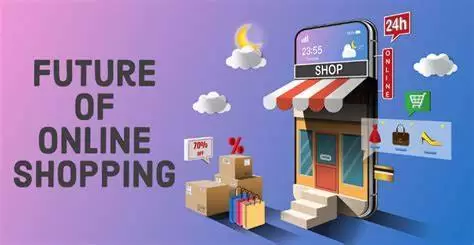The Future of Online Shopping
The Future of Online Shopping in 2025: Trends, Innovations, and Evolving Consumer Expectations
Online shopping has transformed dramatically over the last decade, and by 2025, its evolution will have reached new heights. As consumer expectations continue to shift, and technology continues to advance, the future of e-commerce is poised for even more radical change. Here’s a glimpse at what online shopping will look like in 2025, highlighting key trends and innovations that will define the digital shopping experience.
1. AI-Driven Personalization at Scale
Artificial intelligence (AI) has already begun to enhance online shopping experiences, but by 2025, its role will be even more pervasive and sophisticated. Retailers will leverage AI not just for basic recommendations but for highly personalized shopping journeys that adapt in real-time to individual preferences.
Consumers will enjoy more seamless and intuitive experiences, where AI-driven systems anticipate their needs, from personalized product recommendations to tailored pricing and exclusive offers. Chatbots and virtual assistants will evolve, using natural language processing to provide not only customer service but also to help consumers navigate and discover products. Expect AI to offer a deeper understanding of shopper behavior, creating a more emotionally resonant and convenient shopping experience.
2. Augmented Reality (AR) and Virtual Reality (VR) Shopping
AR and VR will become central to online shopping in 2025. These technologies, already making waves in sectors like fashion and furniture, will become commonplace across industries. With AR, shoppers can not only try on clothes virtually but also interact with products in a fully immersive environment.
In fashion, customers will try on clothes using AR apps, while VR will allow them to walk through virtual stores or attend digital shopping events like product launches and pop-up shops. VR experiences could become a go-to for online buyers wanting to experience a product in a 3D, lifelike setting before making a purchase. Whether it's seeing how a couch looks in a living room or viewing a car's interior, these technologies will revolutionize the way consumers shop online.
3. Seamless Integration of Social Commerce
Social commerce, the ability to shop directly through social media platforms, will become even more integrated into the online shopping experience by 2025. Social media giants like Instagram, TikTok, and Facebook will continue to refine their shopping tools, allowing users to discover and purchase products directly within the app without leaving the platform.
Influencers, content creators, and brands will seamlessly combine entertainment with retail, enabling consumers to make purchases in real-time during live-streamed events or within videos. In 2025, it’s likely that shopping on social media will become as natural as scrolling through a feed, with integrated payment systems, personalized shopping experiences, and instant checkouts making transactions smooth and effortless.
4. Voice Shopping Becomes Mainstream
Voice commerce will take a significant leap forward in 2025. As voice-activated devices and virtual assistants like Alexa, Google Assistant, and Siri continue to evolve, voice shopping will become an everyday norm. Shoppers will use voice commands to browse for products, place orders, and even make payment selections without touching their phones or computers.
This evolution will go beyond simply placing an order. AI will allow voice shopping to become a fully interactive experience, where the assistant not only helps to find products but also provides personalized suggestions based on past purchases, voice tone, and immediate needs. As voice recognition technology improves, voice-enabled shopping will be faster, more secure, and more intuitive.
5. Sustainability and Ethical Shopping as a Norm
By 2025, sustainability will not just be a trend, but a core expectation for consumers. With growing awareness around climate change, ethical sourcing, and waste reduction, consumers will demand that companies provide transparent information about their supply chains, carbon footprints, and sustainability practices.
Expect to see more e-commerce platforms and brands offering eco-friendly options, from carbon-neutral shipping to products made from recycled or sustainable materials. E-commerce companies will increasingly adopt circular business models, allowing customers to return or recycle products, contributing to a more sustainable shopping cycle. The shift towards ethical consumption will also push the use of blockchain technology to verify and showcase ethical sourcing and environmental impact.
6. Advanced Payment Solutions and Cryptocurrency Integration
Payments will become even easier and more diverse by 2025. Digital wallets will dominate, with consumers using services like Apple Pay, Google Pay, and other platforms to check out quickly and securely. In addition, the rise of Buy Now, Pay Later (BNPL) services will continue, enabling more flexible payment plans for consumers.
Cryptocurrency will also gain traction in e-commerce, especially among tech-savvy consumers. By 2025, more online retailers are likely to accept digital currencies like Bitcoin, Ethereum, and even stablecoins as forms of payment. Blockchain technology will be utilized not only for payments but also to enhance supply chain transparency, making online shopping more secure and efficient.
7. Hyperlocal Shopping and Same-Day Delivery
As consumer expectations around speed and convenience continue to evolve, same-day delivery will become standard practice for most e-commerce businesses by 2025. Hyperlocal shopping will become more common, where products are stored in fulfillment centers close to consumers, ensuring faster delivery times and reducing shipping costs.
Robots, drones, and autonomous vehicles will play a crucial role in delivery networks, facilitating lightning-fast deliveries and eliminating logistical bottlenecks. Smart warehouses and AI will help manage inventory and dispatch orders with unprecedented precision, ensuring consumers receive their purchases faster than ever.
8. The Metaverse and Virtual Shopping Environments
By 2025, the Metaverse—an immersive virtual world where users interact in a shared digital space—will play a significant role in e-commerce. Virtual shopping malls, pop-up shops, and branded spaces within the Metaverse will allow consumers to browse and purchase products in 3D, while interacting with other users and digital avatars.
This fully immersive shopping experience could feature virtual try-ons, real-time customer support in the form of avatars, and exclusive virtual products that can be owned and traded digitally. Brands will also host interactive events, launches, and fashion shows in virtual spaces, allowing customers to experience shopping as a social, entertainment-driven activity.
9. AI-Powered Customer Service and Chatbots
Customer service will continue to evolve in 2025, with AI-powered chatbots taking center stage. These bots will become more intuitive, capable of understanding complex queries, solving problems in real-time, and offering highly personalized advice.
The shift from traditional customer service to AI-driven support will not mean the elimination of human interaction but rather a combination of human and AI resources. When consumers need more in-depth assistance, a human representative will step in seamlessly. The AI will handle routine tasks, leaving human agents to focus on more complex customer issues.
10. Privacy and Security Innovations
With growing concerns over data privacy and online fraud, security will be a top priority for both retailers and consumers. By 2025, e-commerce companies will adopt advanced security measures like biometric authentication (facial recognition, fingerprint scanning) for payments, AI-driven fraud detection, and decentralized identity management to protect consumer data.
Consumers will also have more control over their personal information, with tools that allow them to manage privacy preferences and opt into data-sharing practices that suit their comfort levels. Enhanced transparency around data usage will help build trust in e-commerce platforms.
Conclusion: The Future of E-Commerce in 2025
The online shopping landscape in 2025 will be shaped by a combination of cutting-edge technologies, evolving consumer expectations, and sustainability imperatives. As AI, AR/VR, voice commerce, and the Metaverse redefine how people shop, businesses will need to remain agile and innovative to stay competitive. The future promises an online shopping experience that is faster, smarter, more personalized, and more immersive, providing both consumers and retailers with endless possibilities to engage and transact. The future of e-commerce is not just about shopping—it’s about creating experiences that are connected, sustainable, and enjoyable.





